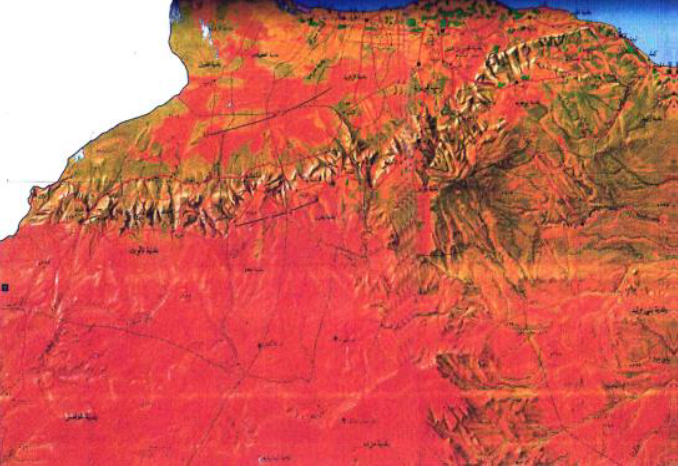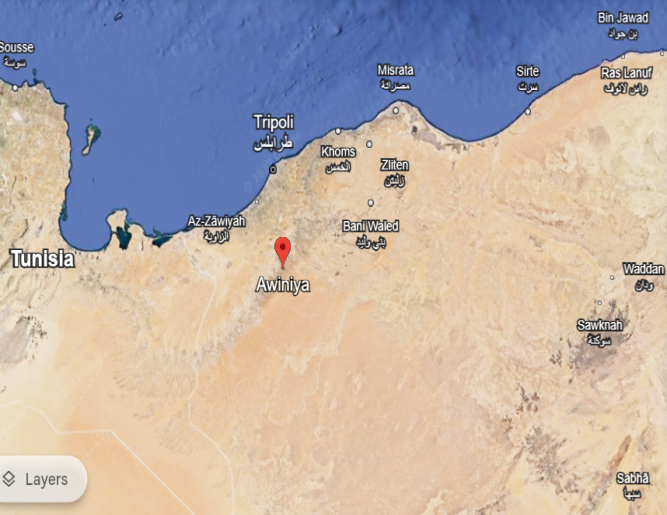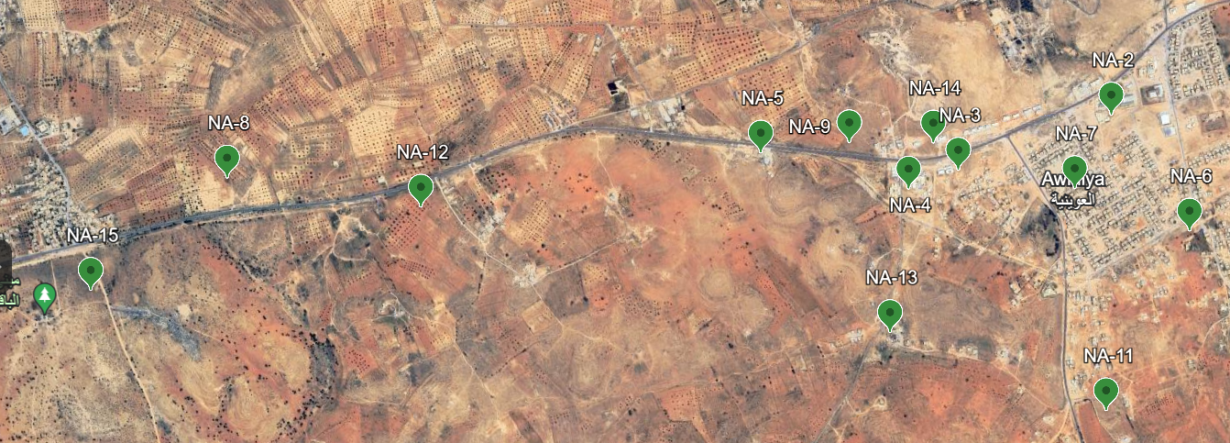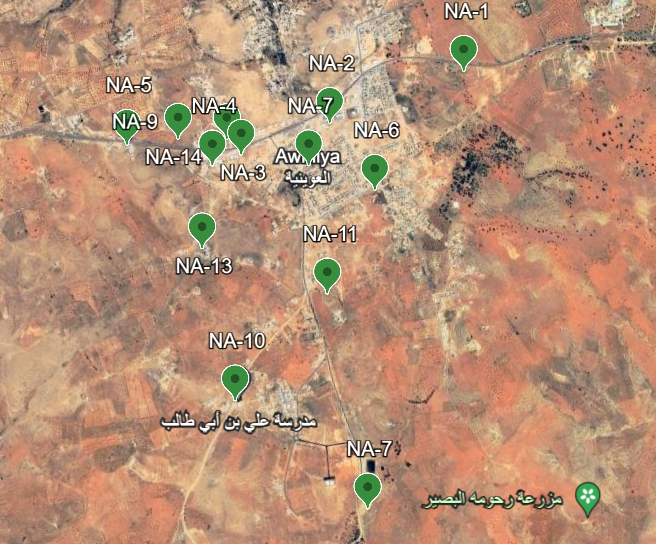Naima .M. Al-kbashy 1 , K.M. Musa 2 , Asma. A. Abouaza 3 Higher Institute of engineering techniques, Tripoli, Libya. tataalola2017@gmail.com 2 Physics Department, Faculty of Science, Tripoli University, Tripoli, Libya. E-mail: Ka.musa@uot.edu.ly 3 Higher Institute of engineering techniques, Tripoli, Libya. HNSJ, 2024, 5(1); https://doi.org/10.53796/hnsj51/14 Download Published at 01/01/2024 Accepted at 14/12/2023
Abstract
Fifteen samples of soil were chosen to achieve this work, the samples were obtained from– Al jabel Algharbi – Awiniya region, Libya. Distributions of natural radionuclides of 238 U, 232Th and 40K in these samples were determined using a high-purity germanium detector (HPGe) with a specially designed shield. The content of uranium, thorium and potassium is lower than permissible levels in all soil samples. To evaluate the radiological hazard from soil in this area the radium equivalent activity (Raeq), absorbed gamma dose rate (D), annual effective dose equivalent (AEDE), external hazard index (Hex) and excess lifetime cancer risk (ELCR) were calculated in this work. The levels of natural radioactivity and radiation hazard parameters were compared with the international recommended values. All obtained results were found to be below the international recommended limit.
Key Words: Natural radionuclides, Soil samples, Health effects, Gamma spectroscopy, Aljabel – Al.Gharbi (Awiniya region) , Libya
عنوان البحث
قياسات النشاط الإشعاعي الطبيعي وزيادة خطر الإصابة بالسرطان مدى الحياة لبعض عينات التربة السطحية في (الجبل الغربي) ومنطقة (العوينية) ليبيا
HNSJ, 2024, 5(1); https://doi.org/10.53796/hnsj51/14
تاريخ النشر: 01/01/2023م تاريخ القبول: 14/12/2023م
المستخلص
تم إختيار خمسة عشر عينة من التربة لإنجاز هذا العمل ، وتم الحصول على هذه العينات من الجبل الغربي – منطقة العوينية – ليبيا . حيث تم قياس تركيز النشاط الإشعاعي للنويدات المشعة الطبيعية لكل من 238 U ، 232Th و 40K في هذه العينات بإستخدام كاشف الجرمانيوم عالي النقاوة ، أظهرت نتائج هذه الدراسة أن تركيزات اليورانيوم والثوريوم والبوتاسيوم أقل من المستوى المسموح به في جميع عينات التربة في هذه المنطقة. ولتقييم الأثار الإشعاعية التي تسببها النويدات المشعة الأرضية على السكان في هذه المنطقة تمت مقارنة مستويات النشاط الإشعاعي الطبيعي ، ومؤشرات المخاطر الأشعاعية بالقيم الموصى بها دولياً مثل : نشاط مكافئ الراديوم ، ومعدل جرعة جاما الممتصة وما يقابلها من الجرعة السنوية الفعالة ، و زيادة خطر الأصابة بالسرطان مدى الحياة ، و مؤشر الخطر الخارجي وقد تبين أن جميع النتائج التي تم الحصول عليها كانت أقل من الحد الموصي به دولياً.
1. INTRODUCTION
The natural radioactivity in the environment is the main source of radiation exposure for the human body. Natural radionuclide in soil contributes a significant amount of background radiation exposure to the population through inhalation and ingestion. It can be also transferred to plants, foods and drinking water. (Algattawi.A et al ., 2019 ). Natural radiation arises from two main sources, cosmic rays and terrestrial radionuclides. The terrestrial radionuclides are the long-lived primordial radionuclides and their daughter nuclides, which have been present on Earth’s crust since the creation of the Earth (M. Degerlier et al., 2008). The soil is the most important source of the terrestrial, The presence of terrestrial radionuclides in soil originates from the disintegrating of rocks through the processes of erosion and deposition, and they are carried to the soil by rain and flows and become an integral component of the soil. The terrestrial component of the natural radiations comes mainly from long-lived primordial radionuclides and their daughter nuclides, which have been present on Earth’s crust since the creation of the Earth. The most important primordial radionuclides present in the soil are the radionuclides with half-lives comparable to the age of Earth from the uranium series, thorium series, and 40K. , Table (1), (Alajeeli .A , 2019).
| Table (1): Radionuclide Half-life (109 years). | |
| Half-life (109 years) | Radionuclide |
| 4.47 | |
| 0.70 | |
| 14.1 | |
| 1.28 | |
Measurements of natural radioactivity in soil have been performed in many parts of the world, mostly for assessment of the dose and risk resulting from them ( Copplestone et al., 2001; Dowdall et al., 2004; El-Bahi et al., 2005). it is necessary to measure and monitor the activity levels of radionuclides in the soil to establish a baseline map and database on environmental radioactivity levels.
2. Materials and methods:
2.1. Site Description of the study area:
Jabal Al-Gharbi Mountain starts from Al-Azeeziah North-East to Wazen West at the Tunisian border, and from Jfarah Valley at the bottom to Nalut at the top. Its height is about 800 m above the sea level (Fig.1 (A)), (Askouri. N et al., 2011).
 |
 |
|
| (A) | (B) | |
| Fig.1: (A) Map of Al-Jabal Al-Gharbi / Libya , (Askouri. N et al., 2011). | ||
(B) Location map of the studied are , Awiniya region .
 |
 |
| Fig.2: Location map of the studied area samples, Awiniya region . | |
2.2. Radioactivity measurements :
Gamma-ray spectrometry was done using a high-purity germanium p-type coaxial detector with 30% relative efficiency. Which is connected to a multi-channel (4096) analyzer. The software used is called APTEC 2000 Energy resolution FWHM of the detector is 1.98 Kev at 1332 kev of Co60 Operating voltage is 3000 Manufacturing company of the detector is Eurysis. 226Ra activity was determined indirectly from the gamma rays emitted by its daughter products (214Pb and 214Bi) where; the concentrations of 214Pb and 214Bi were measured from (295.1(18.7%), 351.9 (35.8%)) KeV and (609.3 (45%), 1120.3(14.9%) KeV photopeaks, respectively. The gamma-ray transitions of 228Ac (911 (29%)) KeV, 212Bi (727.3 KeV (7%)) and 208Tl (583.1 KeV (30%)) were used to evaluate the specific activity of 232Th. 40K was determined directly from the 1460 KeV (10.7%) peak energy (Technical Reports Series, 1989).
2.3. Calculation of activity concentration :
The radioactivity concentration in the environmental samples was obtained using the equarion (1) (Usif. M and Taher. A. , 2008):
Where, A = Activity of the sample in Bq·kg–1; cps = the net counts per second; eff = the counting efficiency of the gamma energy; I = absolute intensity of the gamma-ray; and m is the mass of the sample in kilograms.
- Result and Discussion :
- Activity concentrations of , and :
The values of activity concentration of , and of all studied soil samples were calculated and illustrated in (Table 2). The activity concentrations for radium range ( from 8.72 Bq/kg in sample 3 and sample 11 to 16.88 Bq/kg in sample 2) (Fig.3), from (7.14 Bq/kg in sample 15 ) to (16.66 Bq/kg in sample 7) (Fig.4) and (from 58.05 Bq/kg in sample 3 to 180.18 in sample 8) (Fig.5). The radioelements worldwide average (W.A.) values are 35 Bq/kg for , 45 Bq/kg for , 420 Bq/kg for ( UNSCEAR, 2010 ), the activity concentrations of all studied samples for thorium, radium and potassium are lower than the permissible level.
| Table (2) : The activity concentrations in (Bq/Kg) of , and | |||
| Sample Number | |||
| NA1 | 10.37 | 7.84 | 130.19 |
| NA2 | 16.88 | 15.89 | 110.64 |
| NA3 | 8.72 | 8.96 | 58.05 |
| NA4 | 12.79 | 10.95 | 146.75 |
| NA5 | 15.61 | 13.75 | 173.13 |
| NA6 | 15.41 | 13.26 | 150.19 |
| NA7 | 16.03 | 16.66 | 149.41 |
| NA8 | 16.47 | 14.57 | 180.18 |
| NA9 | 10.26 | 10.69 | 159.40 |
| NA10 | 12.34 | 11.87 | 140.69 |
| NA11 | 8.72 | 7.91 | 131.53 |
| NA12 | 12.44 | 11.96 | 178.92 |
| NA13 | 16.18 | 12.77 | 141.12 |
| NA14 | 10.50 | 9.47 | 136.00 |
| NA15 | 11.47 | 7.14 | 137.97 |
| P.L | 35 | 45 | 420 |
(Fig.3) : The Activity Concentration of
(Fig.4) : The Activity Concentration of
(Fig.5) : The Activity Concentration of
3.2. Radiological hazard indices :
Radium Equivalent (Raeq) :
The radium equivalent (Raeq) index in Bq/kg is a widely used radiological hazard index. It is a convenient index to compare the specific activities of samples containing different concentrations of , and . It was defined on the assumption that 10 Bq/kg of , 7 Bq/kg of and 130 Bq/kg of produce the same gamma dose rate. It was calculated by equation (2) as follows:
Where , and are the activity concentrations of , and in Bq/kg, respectively. Raeq was estimated for the collected samples and is given in Table (3 ), Fig (6). The values of Raeq for all soil samples varied (from 26.01 to 51.36 ) Bq/kg, and were estimated lower than the recommended maximum value of 370 Bq kg-1(Ababneh et al ., 2010 ).
External hazard index (Hex) :
The external hazard index (Hex) represents the external radiation exposure associated with gamma irradiation from radionuclides of concern. The value of Hex should not exceed the maximum acceptable value of one to keep the hazard insignificant. The external hazard (Hex) is defined by the equation (3): ( Jankovic et al., 2008 ).
Where , and are the concentrations in(Bq/ Kg ) of radium, thorium and potassium respectively. The values of Hex for all soil samples varied from (0.07 – 0.13), and were found to be less than 1 as given in Table (3), Fig (7).
Radiation Level Index (Iγ) :
This index can be used to estimate the level of γ-radiation hazard associated with the natural radionuclides in the samples; it is given by the equation (4) :
Where , and are the activity concentration of , , in Bq/kg, respectively. The value of these indexes must be less than unity in order to keep the radiation hazard insignificant, the values of Representative Level Index (Iγ) from ( 0.18 -0.37 ) for all samples are found to be less than 1 given in Table ( 3), Fig (7).
Absorbed dose rate (D) :
The absorbed dose rate D in outdoor air at 1m above the ground level was assessed from the natural activities of , and (Bq.kg− 1) dry Weight was calculated using equation (5) ( Ajayi and Kuforiji, 2001; El-Arabi et al., 2006 ):
The values of for all soil samples varied from (11.59 – 23.42) nGyh-1, and were found to be less than 59 nGyh-1 as given in Table ( 3), Fig (8). This factor is very important to evaluate the annual effective dose in an outdoor environment, AED can be given by equation (6):
The values of for all soil samples varied from (0.014 – 0.029) mSvy-1, and were found to be less than 0.07 mSvy-1 as given in Table ( 3), Fig (9).
Excess lifetime cancer risk (ELCR) :
For outdoor exposure, ELCR can be calculated from outdoor annual effective dose by using the following equation (7) :
Where 66 is the average life expectancy (approximately 66 years) and 0.05 is the fatal risk factor per Sievert, ( Qureshi et al, 2014 ). The values of for all soil samples varied from (0.047 – 0.095) × 10-3, and were found to be less than ( 0.29 × 10-3 ) as given in Table (3), Fig (10).
| Table (3) : The values of Radium equivalent activity, Radioactivity level index, External hazard index, absorbed doses rate D, the annual effective doses AED and excess lifetime cancer risk ELCR for the area under investigation. | ||||||
| Sample Numbe | Bq/Kg | I gamma | D(out) | E(out) | ELCR(out) | |
× 10-3NA131.610.230.0814.650.0180.059NA248.130.340.1321.490.0260.087NA326.010.180.0711.590.0140.047NA439.750.290.1018.250.0220.074NA548.600.350.1322.260.0270.090NA645.940.330.1220.920.0260.085NA751.360.370.1323.200.0280.094NA851.190.370.1323.420.0290.095NA937.820.280.1017.520.0220.071NA1040.150.290.1018.350.0230.074NA1130.160.220.0814.020.0170.057NA1243.330.320.1120.050.0250.081NA1345.310.320.1220.590.0250.083NA1434.530.250.0915.920.0200.064NA1532.320.230.0815.030.0180.061P.L37011590.070.29
| Fig (7) : External hazard index (Hex) and Radiation Level Index (Iγ). | Fig (6) : Radium equivalent (Raeq) in Bq/kg. | |
| Fig (9) : the annual effective dose in an outdoor . | Fig (8) : absorbed dose rate D in outdoor in . | |
| Fig (10) :The excess lifetime cancer risk ELCR. | ||
5 . Conclusions :
In the work presented here, The obtained results illustrate the following important observation: The activity concentrations of , and were measured by a high-purity germanium (HPGe) detector for the 15 soil samples. The measured activity concentrations of , and in all soil samples are lower than the permissible limit reported in UNSCEAR (2010). The radium equivalent, external hazard index, and dose rate have low values. The ELCR factor assessed during this work based on outdoor effective dose (Eout) was found to be lower than the permissible level. This indicates that the soils considered were safe and can be used in the building of dwellings and sources of construction material without giving any radiological hazard to the local population. The results of measurements will serve as baseline data and background reference level for the Awiniya region, Libya, for drawing a radiological map of this region.
6 . References :
AbabnehZ.Q, El-Omari ,H . Rasheed, M . El-Najjar T. and A. Ababneh, (2010), (Assessment of gamma emitting radionuclides in sediment cores from the Gulf of Aqaba), Red Sea. RadiatProtDosim., vol. 141, pp. 289-298.
Ajayi, I. and Kuforiji, O. (2001), (Natural radioactivity measurements in rock samples of Ondo and Ekiti States in Nigeria), Radiation Measurements, 33(1), 13–16.
Alajeeli.A.S, (2019), ( natural radioactivity of surface Soil samples in coastal regions between Tripoli and Zawiya) , Journal of Faculties of Education ,The Fourteen issue of june.
Algattawi. A . A , Fayez-Hassan. M, Khalil E. I. and Abo Elez. H, (2019), (Natural radioactivity and associated dose rates of soil samples in different Libyan regions), Journal of Nuclear and Radiation Physics,Vol. 14 pp 1-10.
Copplestone, D.; Johnson, M.S. and Jones, S.R., (2001), (Behavior and Transport of Radionuclides in Soil and Vegetation of Sand Dune Ecosystem), Journal of Environmental Radioactivity, 55, 93-108.
Degerlier M. And Ozger G., (2008), (Assessment of Gamma Dose Rates In Air In Adana/Turkey), Radiation Protection Dosimetry,132, No.3,350-356,.
Dowdall, M., Vicat, K., Frearson, I., Gerland, S., Lind, B. and Shaw, G., (2004), (Assessment of the Radiological Impacts of Historical Coal Mining Operations on the Environment of Ny-Alesund, Svalbard), Journal of Environmental Radioactivity, 71, 101-114,
El–Arabi, A., Abbady, A. G. and Hussein, A. (2006), (Gamma–ray measurements of natural radioactivity in sedimentary rocks from Egypt), Nuclear Science and Techniques, 17(2), 123–128.
El-Bahi, S.M., El-Dine, N.W., Ahmed, F., Sroor, A. and Abdl Salaam, M.M., (2005), (Natural Radioactivity Levels for Selected Kinds of Egyptian Sand), Isotopes in Environmental and Health Studies, 41, 161-168.
Jankovic, M .Todorovic,D and Savanovic ,M (2008), (Radioactivity measurements in soil samples collected in the Republic of Srpska), Radiation Measurements, vol. 43, pp. 1448-1452.
Najim A. Askouri , Miftah O. Hussain , Abdoul-Rahman S. S. Al-Ojaily (2011), (Natural radioactivity survey in Al-Jabal Al-Gharbi Mountain Region Libya) ,Vol. 9, No. 14, PP.96-101.
Qureshi Aziz Ahmed, Tariq Shahina, Ud Din Kamal, Manzoor Shahid, Calligaris Chiara and Waheed Abdul., (2014), (Evaluation of excessive lifetime cancer risk due to natural radioactivity in the rivers sediments of Northern Pakistan), Journal of Radiation Research and Applied Sciences, Issue 7, pp 438-447.
Technical Reports Series No.295, (1989), (Measurement of Radionuclides in Food and the Environment), A Guidebook, IAEA, Vienna-Austria.
UNSCEAR, 2010. Sources and Effects of Ionizing Radiation. Report to General Assembly with Scientific Annexes (New York, United Nations Scientific Committee on the Effect of Atomic Radiation ).
Usif, M. A. and Taher, A. E. (2008), (Radiological Assessment of Abu-Tartur Phosphate, Western Desert Egypt), Radiation Protection Dosimetry, Vol. 130, No. 2, pp. 228-235.
